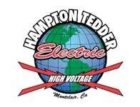Grounding: The process or method of providing an electrical connection between electric equipment and earth, or to some conductive medium that is at earth potential. When grounding lines only approved grounding cables and approved clamping devices shall be used. A Single Point Grounding Cluster shall be mounted below the work area first. Approved grounding cables shall be connected to an approved ground, then to the cluster mount and lastly to the conductors. When removing grounds, the grounding cable shall be disconnected from each conductor first, the cluster next and lastly from the approved ground. Live line tools shall always be used for installing and removing ground cables. Only approved grounding jumper equipment shall be used. Temporary grounding jumpers shall be secured to permanently grounded objects in the following order of preference:
- Station Grounds
- Primary Neutral Conductor of a 4-wire circuit
- Steel Towers
- Anchor Rods
If none the above are available, an approved, temporary ground rod shall be used. Temporary grounding cable shall be flexible-stranded conductor of sufficient current carrying capacity to activate protective devices without damage to the cable, but not less than Flexible 1/0 Stranded Copper. Cables shall be equipped at both ends with approved clamps that apply firm pressure and can be applied with live line tools. When lines or equipment that may become energized from any source rated 50 volts or more to ground have been removed from service to perform work on them, all phases shall be grounded or the work shall be performed using Rubber Gloves or Live Line Tools and treated as though the equipment were energized. Before grounding the phases, a check or test for voltage shall be made with an approved testing devise. Grounds may be removed for equipment testing purposes, but work on the equipment not associated with the test shall be stopped until the grounds are replaced. When replacing fuses installed on the high-voltage
side of power transformers which cannot be handled with live line tools, safety grounding may be omitted between the fuse and the source of energy if an open air switch, visible to the worker, isolates the fuse from the source of energy. Safety grounding may also be omitted between the fuse and the transformer, or on the low-voltage side of the transformer, if an open air switch (or switches) on the secondary side of the transformer, visible to the worker, isolates the fuse from possible back-feed through the transformer. Safety grounding on the primary side of the transformer is preferred to grounding on the secondary side. “Two (2) open points of isolation or Ground It”
Whenever possible, a ground shall be placed on all phase conductors at the work structure. On metal structures, conductors shall be considered as bonded together and grounded when each is separately grounded to the structure. On wood structures equipped with ground wires or grounded neutrals, the grounding system serves as the ground. On structures without ground wires, guy anchors where available or an approved temporary driven ground, preferably 50 feet away from any area where anyone is likely to be, may serve as the ground. When a conductor, neutral, or ground wire is to be opened, under conditions specified in (E4.8, E4.9 & E4.10) a jumper shall be placed across the opening.
